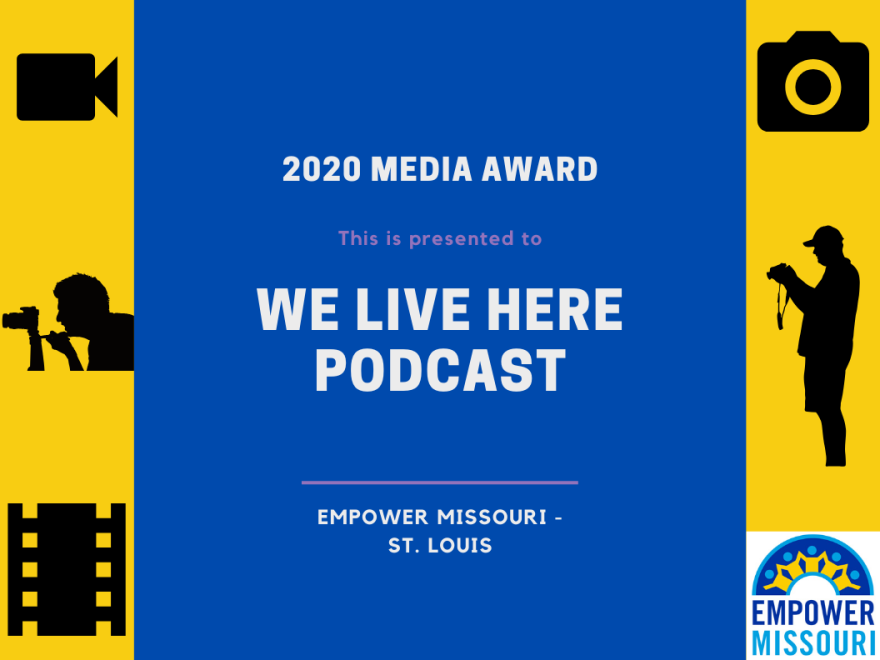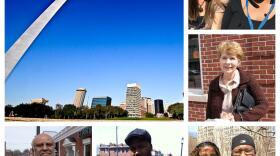
It’s been 10 years since Michael Brown Jr. was killed and the Ferguson Uprising that followed. To honor that history and reflect on where St. Louis is today, St. Louis Public Radio is bringing back the podcast “We Live Here” for a special season.
In the show, host Chad Davis and producer Danny Wicentowski reflect on some of the truths that Ferguson exposed, why there still is an open wound a decade later, and how community members continue to push for a better future.
Season 10: 10 Years after the Ferguson uprising
It’s been 10 years since Michael Brown Jr. was killed and the Ferguson Uprising that followed. To honor that history and reflect on where St. Louis is today, St. Louis Public Radio is bringing back the podcast “We Live Here” for a special season.
In the show, host Chad Davis and producer Danny Wicentowksi reflect on some of the truths that Ferguson exposed, why there still is an open wound a decade later, and how community members continue to push for a better future.
-
It’s been 10 years since Michael Brown was killed and the Ferguson Uprising that followed. To honor that history, We Live Here is returning for a special season with host Chad Davis and producer Danny Wicentowski. They reflect on some of the truths that Ferguson exposed, why there still is an open wound a decade later, and how community members continue to push for a better future.
-
Michael Brown Jr. has become a symbol and a gateway for people to talk about racial injustice and policing. This episode of We Live Here explores how people view Brown’s legacy, what young adults today know about his story and how his memory has shaped new conversations about race and justice.
-
Many people found their power and voices during the Ferguson Uprising. Some used streaming technology as they found themselves defining their own class of media, with no editors and no rules.
-
What do you do when you get so angry, the emotion overtakes you? When injustice sparks a fire that won’t die down? For artists during the Ferguson Uprising, their craft offered them a way to make sense of Michael Brown Jr.’s killing. This special episode features songs, poems and a play from St. Louis-based artists who — 10 years later — are still reflecting on how Ferguson changed them and their art.
-
Ferguson exposed systems that disenfranchise Black St. Louisans and fail their basic mandates to provide safety, health and community to the people who depend on them. Inspired by the Uprising and driven by experience and anger, many people found their voices and created their own new systems designed to help their community thrive.
-
In St. Louis, many Black families moved to St. Louis County for better school districts. But after some time, those districts started having their own issues: white flight, decaying property values and consolidations. Some families moved even further northwest, only to face neighbors trying to prevent Black history from being taught.
-
On Wednesday, Aug. 6, St. Louis Public Radio and NPR news co-hosted "Ferguson and Beyond: A Community Conversation 10 Years Later" at Greater St. Mark Family Church, just miles from the epicenter of protests sparked by the killing of Michael Brown, Jr. by a Ferguson police officer in August 2014.
-
Episode 7: In 1972, an uprising exposed the Veiled Prophet and laid a path for Ferguson's protestersWhat happens to people who feel elite, and untouchable, when the city around them rises up to expose and oppose them? What happens when power takes a different shape — obscuring its nature and staying in its position?
-
Kayla Reed and Brittany Packnett Cunningham found their voices as activists during the Ferguson Uprising. They also forged a bond and strong friendship. So what happens when Brittany leaves St. Louis and Kayla stays?
Request a Transcript
Transcripts for St. Louis Public Radio produced programming are available upon request for individuals with hearing impairments.
To request a transcript for We Live Here,
let us know the episode title and contact welivehere@stlpr.org.
See more Recent Stories.
See more Historical Coverage.
Previous We Live Here Episodes
-
We didn’t want to just tell another story about the inequalities that exist in our region. We wanted to tear into the issues, break apart the theory from the reality, demonstrate how the systemic problems that plague our region play out in real people’s lives. And we want to know why we still have these problems — no matter how much academic research and scholarly material there is available to explain the existence of racial inequality, why does it still exist? And so, we came up with We Live Here.
-
Within St. Louis' system of municipalities, people are largely divided — white, black, rich and poor. They rarely live next to each other.
-
Now that we've looked at the jigsaw puzzle of St. Louis County, we consider the children. In a place where people from different backgrounds — and especially different races — seldom live next to each other, we ask the question: What does that mean for kids?
-
This episode of We Live Here is all about talking about race without actually talking about race.
-
We Live Here spent the last several weeks ramping up to explore race in St. Louis and, specifically, how systems intersect with people to create a lot of the inequality in our region ... and around the country. Now, we are moving from the general to the specific. We will spend the next several months exploring the criminal justice system.
-
On this episode of We Live Here we introduce you to four police officers who discuss not only what life is like during the day-to-day grind of work, but also the question of whether or not race makes a difference for African-American officers in majority white police departments.
-
In this episode of We Live Here, we explore the price and perils of our public defender system.
We Live Here Seasons
-
Season 1
21 episodes (Mar 2015 - Jan 2016)
-
Season 2
18 episodes (Apr 2016 - Jan 2017)
-
Season 3
19 episodes (Jun 2017 - Dec 2017)
-
Season 4
20 episodes (Apr 2018 - Dec 2018)
-
Season 5
8 episodes (Oct 2019 - Dec 2019)
-
Season 6: COVID-19
11 episodes (Mar 2020 - Jun 2020)
Lauren Brown and Jia Lian Yang
We Live Here puts a racial and economic equity lens on the outbreak of COVID-19… and recovery from it.
-
Season 7: Uprising
14 episodes (Jul 2020 - Dec 2020)
Lauren Brown and Jia Lian Yang
Season 7 of We Live Here examines how people are rising up for Black lives around the world. For every moment captured on the news, there are a series of decisions that led us here to a time when record numbers of people are discontent with the status quo.
-
Season 8: Environmental Racism
13 episodes (Feb 2021 - Jun 2021)
Lauren Brown and Jia Lian Yang
How do we achieve a healthy life? And what kind of world do we want to leave for the next generation? These are profound questions for a region that boasts some of the most prestigious hospitals in the nation and is home to residents with some of the worst health outcomes.
-
Season 9
7 episodes (Aug 2021 - Nov 2021)
-
Season 10: 10 Years after the Ferguson Uprising
Ongoing (Aug 2024+)
Chad Davis and Danny Wicentowski
It’s been 10 years since Michael Brown Jr. was killed and the Ferguson Uprising that followed.
Host Chad Davis and producer Danny Wicentowksi reflect on some of the truths that Ferguson exposed, why there still is an open wound a decade later, and how community members continue to push for a better future.
-
We Live Here Auténtico!
13 episodes (May 2022 - Jan 2023)
Alejandro Santiago Ortega, Gabriela Ramirez-Arellano, and Jade Harrell
Created by St. Louis Latinx professionals, the “Auténtico!” podcast is committed to shaping Latinx identity. Each episode reveals stories and lessons learned from bilingual Latinx professionals and small business owners.
-
We Live Here Women
1 episode (Jan 2023)
We Live Here centers the voices, concerns, perspectives and experiences of Women.
Awards

2020 - Empower Missouri Media Award

2019 - Kaleidoscope Award


























